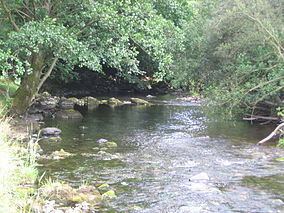- average 8.94 m/s (316 cu ft/s) Area 109 ha Country United Kingdom | Length 32 km Bridges Kent Viaduct | |
 | ||
- max 441.0 m/s (15,574 cu ft/s) 8 January 2005 - min 0.47 m/s (17 cu ft/s) 24 August 1984 | ||
The River Kent is a short river in the county of Cumbria in England. The river originates in hills surrounding Kentmere, and flows for around 20 miles (32 km) into the north of Morecambe Bay. The Lake District National Park includes the upper reaches of the river within its boundaries.
Contents
Map of River Kent, United Kingdom
The river passes through Kentmere, Staveley, Burneside, Kendal and Sedgwick. Near Sedgwick, the river passes through a rock gorge which produces a number of low waterfalls. This section is popular with kayakers as it offers high quality whitewater for several days after rain.
The village of Arnside lies alongside the Kent estuary. On high spring tides, a tidal bore known as the Arnside Bore forms in the estuary opposite Arnside. The wave is often about 0.5m high.
TributariesEdit
The rivers Mint, Sprint and Gowan join the Kent to the north of Kendal, with the river also joined by the River Gilpin and River Winster as it nears its estuary.
Lingmell Gill (into Kentmere Reservoir)
Skeel Gill and Bryant's Gill
Ullstone Gill
Nunnery Beck
Kill Gill
Hall Gill
Park Beck
Hall Beck
River Gowan
River Sprint
River Mint
River Gilpin
River Bela
River Winster
EnergyEdit
Near the source of the river is Kentmere Reservoir, which was constructed in the mid-19th century to control the flow of the river for the benefit of water mills. The river was used to power numerous mills in the past, including two at Staveley, Kentmere water mill, and also the James Cropper paper factory at Burneside. One of the weirs at Staveley produces electricity for Staveley Mill Yard via a micro hydro scheme. There is also scope for micro hydro upstream at Kentmere.
WildlifeEdit
The river is a designated Special Area of Conservation, primarily as an important habitat for the endangered White-clawed Crayfish (Austropotamobius pallipes).
Fish species include salmon and trout. In the twentieth century fish ladders were constructed alongside the dams of mill-ponds to allow migratory fish to swim up to Kentmere. In 2013 DEFRA funding was announced for eel passes at Stramongate weir in Kendal and Basinghyll fish counter.
